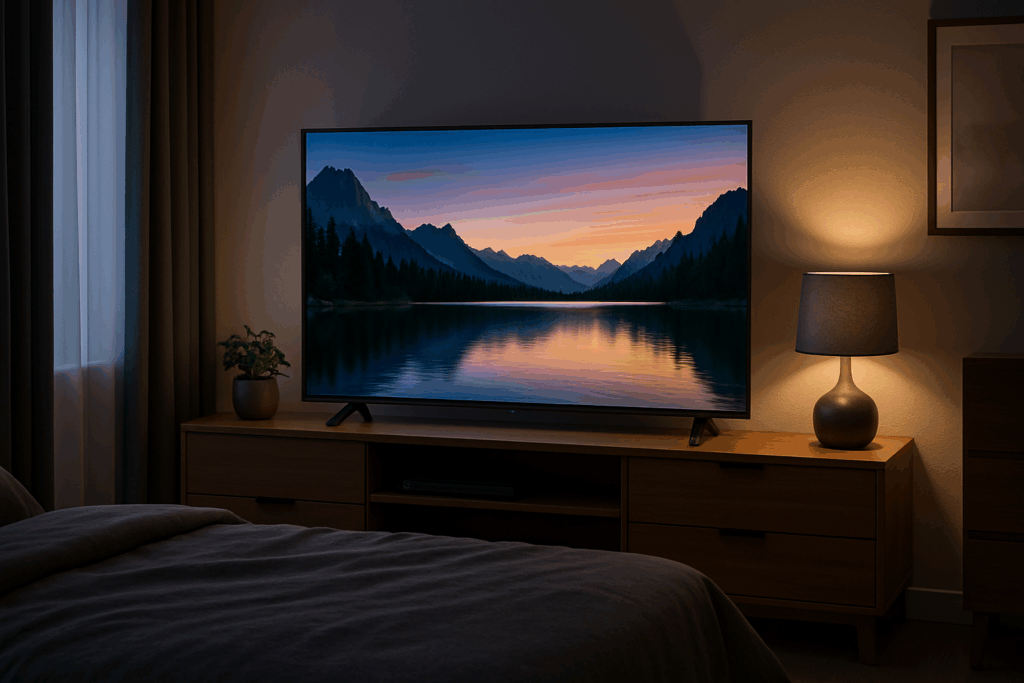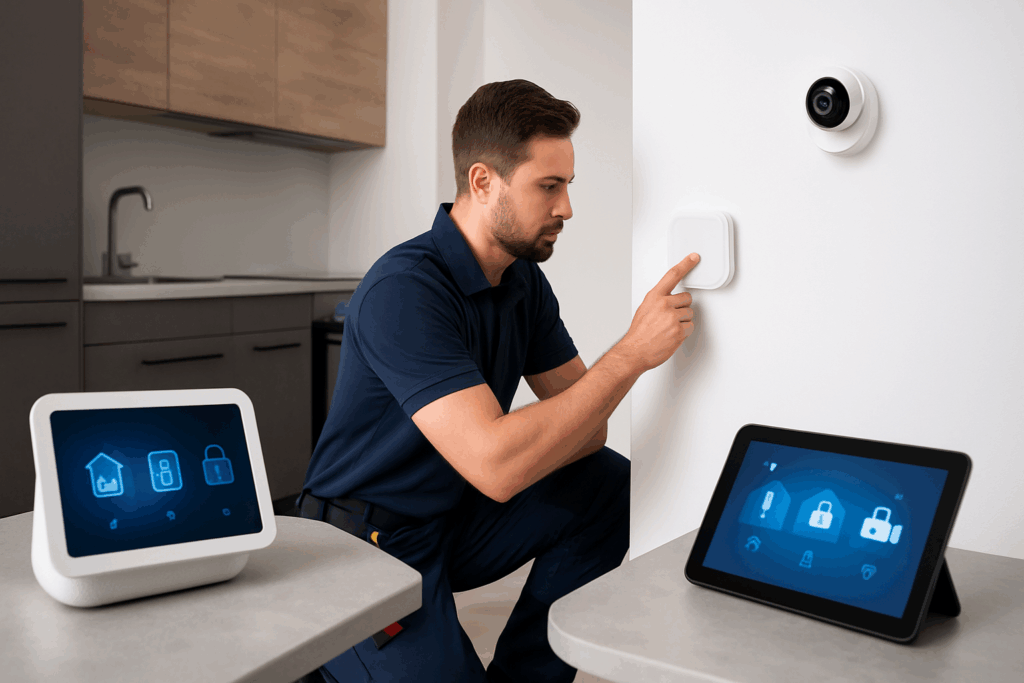Smart homes are no longer futuristic—they’re here, and they’re changing the way Americans live. From voice-controlled lighting to energy-saving thermostats and AI-driven security systems, smart home installation is transforming houses across the country.
As a smart home technician working hands-on with US homeowners, I see the excitement, the questions, and yes, the common mistakes people make. In this guide, I’ll walk you through everything you need to know about smart home installation—from benefits to costs, devices, and future trends—so you can make an informed decision and enjoy a truly connected lifestyle.
What is Smart Home Installation?
Smart home installation is the process of setting up connected devices in your home that can be controlled remotely through apps, voice assistants, or automated routines.
There are two main approaches:
- DIY Setup: Buy devices (like a Ring camera or Nest thermostat) and install them yourself.
- Professional Installation: A technician designs and sets up a system tailored to your home.
📊 Did you know? As of 2025, more than 64 million US households use at least one smart home device, and the number is growing fast.
Top Benefits of Smart Home Installation
Installing smart devices isn’t just about convenience. It delivers real-world benefits that impact your safety, comfort, and wallet.
- Enhanced Security
- Smart locks, video doorbells, and motion sensors protect your home 24/7.
- Receive instant alerts on your phone when someone approaches.
- Energy Efficiency & Cost Savings
- Smart thermostats like Nest and Ecobee reduce energy bills by up to 20%.
- Automated lighting saves power by turning off when not in use.
- Hands-Free Convenience
- Control lights, music, or appliances with simple voice commands.
- Use routines like “Goodnight” to lock doors and turn off lights at once.
- Increased Property Value
- Homes with smart systems sell faster and at higher prices.
- Real estate buyers in the US increasingly look for “ready-made smart homes.”

Smart Devices Every US Homeowner Should Consider
When planning a smart home setup, these are the core devices I recommend:
- Smart Speakers & Hubs
- Amazon Echo, Google Nest Hub, or Apple HomePod
- Smart Lighting
- Philips Hue, LIFX, or WiZ for voice-controlled, energy-efficient lights
- Smart Thermostats
- Nest Learning Thermostat, Ecobee SmartThermostat
- Smart Security Systems
- Ring Alarm, Arlo cameras, or SimpliSafe kits
- Smart Appliances
- Refrigerators, ovens, and washers with Wi-Fi control
How to Plan Your Smart Home Installation
Before rushing to buy gadgets, create a step-by-step plan:
- ✅ Check Your Wi-Fi Strength – Weak internet equals poor performance.
- ✅ Choose Your Ecosystem – Amazon Alexa, Google Assistant, or Apple HomeKit.
- ✅ Set a Budget – Entry-level setups can start at $500, while full automation runs into thousands.
- ✅ DIY or Pro Install? – Decide if you’ll install devices yourself or hire a technician.
Professional Smart Home Installation: What to Expect
Hiring a certified installer ensures your devices work together seamlessly. Here’s what usually happens:
- Consultation – Technician surveys your home and recommends devices.
- Installation – Mounting cameras, wiring, configuring thermostats, and syncing devices.
- Setup & Training – Connecting to apps, customizing automation routines, and showing you how to use everything.
📊 Cost Comparison Table (2025 US Averages)
| Service/Device | DIY Cost (Self-Install) | Pro Install Cost |
|---|---|---|
| Smart Thermostat (Nest/Ecobee) | $200 – $300 | $400 – $600 |
| Video Doorbell (Ring) | $100 – $250 | $250 – $450 |
| Security Camera System (3–4 units) | $300 – $600 | $600 – $1,200 |
| Whole-Home Setup (10+ devices) | $1,500 – $2,500 | $3,000 – $6,000 |
⚡ Pro Tip: While professional installation costs more upfront, it prevents compatibility headaches and ensures your devices run smoothly.
Common Mistakes to Avoid in Smart Home Installation
Even tech-savvy homeowners make errors. Watch out for these:
- ❌ Skipping Wi-Fi Upgrades – Smart homes need strong routers and sometimes mesh systems.
- ❌ Mixing Incompatible Devices – Not all brands “talk” to each other.
- ❌ Ignoring Privacy Settings – Always enable two-factor authentication.
- ❌ Poor Placement of Sensors – Security cameras should cover entry points, not random corners.
Smart Home Installation Costs in the US (2025 Guide)
Smart homes can be affordable or premium, depending on scale.
- Entry-Level Setup (Basic automation): $500 – $1,500
- Mid-Tier Setup (Security + climate control): $2,000 – $4,000
- High-End Smart Home (Full automation + appliances): $5,000 – $15,000+
Hidden Costs to Watch Out For
- Subscription fees for cloud storage (Ring, Arlo, Nest).
- Upgrading routers or adding Wi-Fi extenders.
- Occasional device replacements or updates.
Future Trends in Smart Home Technology
The smart home industry is moving fast. Here’s what’s next in 2025 and beyond:
- AI-Driven Automation – Homes that “learn” your habits and adjust automatically.
- Energy Management – Smart grids and integration with solar panels + EV chargers.
- Smarter Security – Facial recognition and advanced biometric locks.
- US Regulations – Federal standards on data privacy in connected homes.

Conclusion: Is Smart Home Installation Worth It?
Absolutely—when done right. Smart homes deliver security, savings, and convenience while adding resale value. Whether you start small with a smart thermostat or go big with full-home automation, planning and proper installation are key.
As a US-based smart home technician, my advice is simple:
- Start with your needs, not trends.
- Build a compatible ecosystem.
- Invest in professional installation if you want reliability from day one.
👉 Ready to upgrade your living space? Consider consulting a certified technician to make sure your home is future-proof, secure, and truly smart.
❓ Frequently Asked Questions About Smart Home Installation
1. What is included in smart home installation?
Smart home installation typically includes setting up devices like smart thermostats, lighting, door locks, cameras, and security systems. A technician will connect them to your Wi-Fi, integrate them with your chosen ecosystem (Alexa, Google, or Apple HomeKit), and customize routines for convenience.
2. How much does smart home installation cost in the US?
The cost varies depending on the devices and level of automation:
- Entry-level setups: $500 – $1,500
- Mid-range systems: $2,000 – $4,000
- Full-home automation: $5,000 – $15,000+
Professional installation adds to the cost but ensures compatibility and reliability.
3. Is it better to DIY or hire a professional?
DIY smart home installation is cheaper and fine for a few devices. However, professional installation is better for larger systems because it prevents compatibility issues, ensures correct placement, and provides training on how to use your devices.
4. What are the main benefits of smart home installation?
The biggest benefits include:
- Better security with cameras, locks, and sensors
- Energy savings through smart thermostats and lights
- Hands-free convenience with voice/app control
- Higher property value for future resale
5. Which smart home devices should I start with?
If you’re new to smart homes, begin with:
- A smart thermostat (Nest or Ecobee)
- A video doorbell (Ring or Google Nest)
- Smart lights (Philips Hue or LIFX)
- A smart hub/speaker (Amazon Echo or Google Nest Hub)
6. Can smart home systems save money on energy bills?
Yes. Smart thermostats can cut heating/cooling bills by up to 20%, while smart lights and plugs reduce wasted electricity. Over time, these savings can offset installation costs.
7. Are smart home devices secure?
Smart home devices are safe if installed and maintained properly. Always:
- Use two-factor authentication
- Regularly update device software
- Choose trusted brands
- Secure your Wi-Fi with a strong password
8. What’s the future of smart home technology in the US?
In 2025 and beyond, we’ll see more AI-driven automation, integration with EVs and solar panels, and stricter data privacy standards for connected devices.
Frequently Asked Questions About Smart Home Installation
What is included in smart home installation?
Smart home installation typically includes setting up devices like smart thermostats, lighting, door locks, cameras, and security systems. A technician will connect them to your Wi-Fi, integrate them with your chosen ecosystem (Alexa, Google, or Apple HomeKit), and customize routines for convenience.
How much does smart home installation cost in the US?
The cost varies depending on the devices and level of automation:
- Entry-level setups: $500 – $1,500
- Mid-range systems: $2,000 – $4,000
- Full-home automation: $5,000 – $15,000+
Is it better to DIY or hire a professional?
DIY smart home installation is cheaper and fine for a few devices. However, professional installation is better for larger systems because it prevents compatibility issues, ensures correct placement, and provides training on how to use your devices.
What are the main benefits of smart home installation?
The biggest benefits include:
- Better security with cameras, locks, and sensors
- Energy savings through smart thermostats and lights
- Hands-free convenience with voice/app control
- Higher property value for future resale
Which smart home devices should I start with?
If you’re new to smart homes, begin with:
- A smart thermostat (Nest or Ecobee)
- A video doorbell (Ring or Google Nest)
- Smart lights (Philips Hue or LIFX)
- A smart hub/speaker (Amazon Echo or Google Nest Hub)
Can smart home systems save money on energy bills?
Yes. Smart thermostats can cut heating/cooling bills by up to 20%, while smart lights and plugs reduce wasted electricity. Over time, these savings can offset installation costs.
Are smart home devices secure?
Smart home devices are safe if installed and maintained properly. Always:
- Use two-factor authentication
- Regularly update device software
- Choose trusted brands
- Secure your Wi-Fi with a strong password
What’s the future of smart home technology in the US?
In 2025 and beyond, we’ll see more AI-driven automation, integration with EVs and solar panels, and stricter data privacy standards for connected devices.